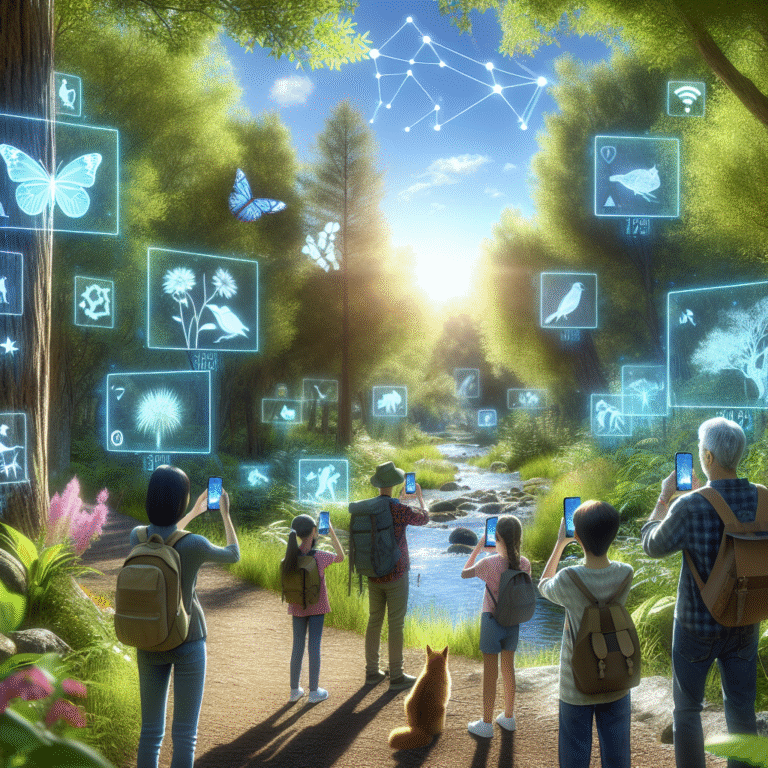
Explore Nature with AR Learning Apps for Outdoor Adventures
In today’s fast-paced, digitally connected world, outdoor adventures are more important than ever. They provide a necessary break from screens and promote physical well-being, mindfulness, and a deeper connection to the environment. But what if technology could enhance, rather than detract from, your time in nature?
Welcome to the exciting world of Augmented Reality (AR) learning apps — a cutting-edge approach to outdoor exploration that’s transforming how kids, families, students, and even seasoned hikers engage with the natural world. With AR tools in their pocket, nature lovers can now identify plants, explore geological formations, and learn about wildlife in real-time, all while enjoying the great outdoors.
In this post, we’ll explore how AR learning apps are revolutionizing outdoor education and adventure. We will dive into the top apps, their features, their educational value, and how people from all walks of life can use them to enhance their outdoor experiences.
What Is Augmented Reality and How Does It Work Outdoors?
Augmented Reality (AR) is a technology that overlays digital elements like images, sounds, or text onto the real world through the lens of a smartphone or AR glasses. When applied to nature and outdoor learning, AR apps use GPS data, camera feeds, and visual recognition software to provide real-time information about your environment.
Think of it as a live guidebook in your hand — point your device at a tree and instantly receive data about the species, its age, its role in the ecosystem, and local folklore. Or aim your phone at a mountain trail and get 3D directions, warnings about steep paths, or updates on nearby wildlife crossings.
Why Use AR for Nature Exploration?
- Real-time learning: Immediate identification of plants, animals, geological features, or constellations.
- Interactive experiences: Many AR apps gamify learning, making it more engaging for kids and adults.
- Accessibility: These tools make nature education available to those without a science background.
- Environmental awareness: By learning more deeply about local ecosystems, users often develop a greater sense of stewardship and responsibility.
Top AR Learning Apps for Outdoor Adventures
- Kid-friendly and COPPA compliant
- Contributes to citizen science initiatives via iNaturalist (optional)
- Rich species database
- Beautiful, immersive overlays
- Works offline
- Educational details on planetary motion and celestial events
- Multilingual support in over 30 languages
- Strong social sharing and community features
- Includes care tips for gardeners
- Interactive storytelling
- Real-time hazard alerts
- Customizable trail information
- Wide accessibility
- Easy to use
- Constant improvement via machine learning
1. Seek by iNaturalist
Platform: iOS and Android
Best for: Plant and animal identification, citizen science
2. SkyView Lite
Platform: iOS and Android
Best for: Stargazing and astronomy
3. PlantSnap
Platform: iOS and Android
Best for: Plant identification
4. AR Trails
Platform: iOS
Best for: Guided hiking experiences
5. Google Lens (Nature Use)
Platform: iOS and Android
Best for: General identification on the go
Benefits for Different Age Groups and Lifestyles
- Families with Children: Turn a weekend hike into an educational scavenger hunt.
- Educators and Homeschoolers: Create research projects using app-collected observations.
- Solo Hikers and Backpackers: Gain safety and insights with AR Trails and Google Lens.
- Seniors and Accessibility Users: Democratize access to naturalist-level knowledge.
Real-Life Impact: A Few Case Studies
- Ecotourism Initiatives: Costa Rica preserves using AR to teach visitors about endangered species.
- Urban Exploration: AR walking tours in New York and London revealing hidden biodiversity.
- Citizen Science: University of Florida study showing 40% better retention with Seek vs. textbooks.
Environmental Responsibility Through Technology
When users identify native species or learn about at-risk ecosystems, they often become motivated to protect them. Apps like iNaturalist even feed data into biodiversity databases tracking migration, disease, and invasives. This fusion of learning and action supports sustainability and a “leave no trace” ethic.
Tips for Using AR Learning Apps Effectively
- Download maps and data before going off-grid.
- Use power-saving settings to preserve battery.
- Limit screen time to avoid distraction from nature.
- Turn walks into games by creating species checklists.
- Log and share findings via iNaturalist or similar.
Potential Downsides — and How to Mitigate Them
- Distraction: Use apps only for specific inquiries.
- Privacy: Check data policies carefully.
- Battery Dependency: Always carry analog backups like maps or compasses.
Final Thoughts: Blending Nature with Technology Mindfully
AR in outdoor exploration harmonizes digital tools with ecological appreciation, informing, inspiring, and empowering users to protect our planet.
Call to Action
- Download one of the apps above before your next hike.
- Share your discoveries on social media.
- Follow iNaturalist or National Geographic to stay engaged in citizen science.
